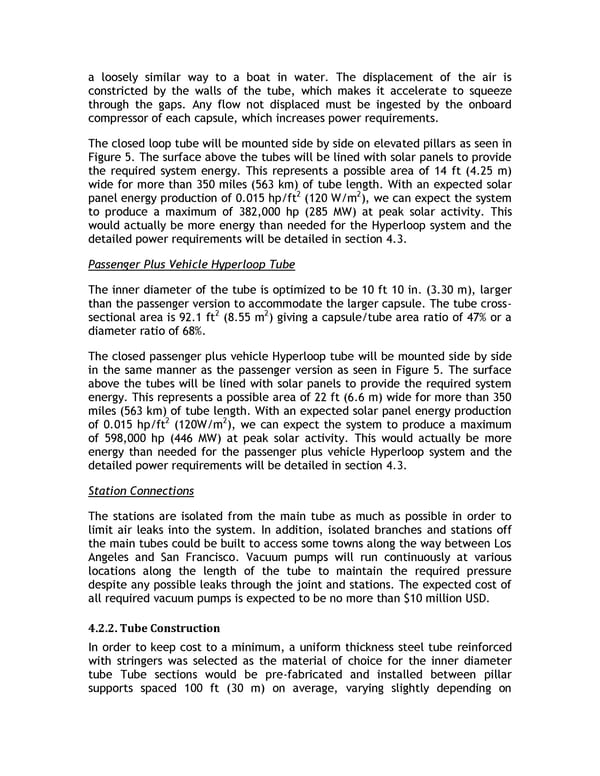a loosely similar way to a boat in water. The displacement of the air is constricted by the walls of the tube, which makes it accelerate to squeeze through the gaps. Any flow not displaced must be ingested by the onboard compressor of each capsule, which increases power requirements. The closed loop tube will be mounted side by side on elevated pillars as seen in Figure 5. The surface above the tubes will be lined with solar panels to provide the required system energy. This represents a possible area of 14 ft (4.25 m) wide for more than 350 miles (563 km) of tube length. With an expected solar 2 2 panel energy production of 0.015 hp/ft (120 W/m ), we can expect the system to produce a maximum of 382,000 hp (285 MW) at peak solar activity. This would actually be more energy than needed for the Hyperloop system and the detailed power requirements will be detailed in section 4.3. Passenger Plus Vehicle Hyperloop Tube The inner diameter of the tube is optimized to be 10 ft 10 in. (3.30 m), larger than the passenger version to accommodate the larger capsule. The tube cross- 2 2 sectional area is 92.1 ft (8.55 m ) giving a capsule/tube area ratio of 47% or a diameter ratio of 68%. The closed passenger plus vehicle Hyperloop tube will be mounted side by side in the same manner as the passenger version as seen in Figure 5. The surface above the tubes will be lined with solar panels to provide the required system energy. This represents a possible area of 22 ft (6.6 m) wide for more than 350 miles (563 km) of tube length. With an expected solar panel energy production 2 2 of 0.015 hp/ft (120W/m ), we can expect the system to produce a maximum of 598,000 hp (446 MW) at peak solar activity. This would actually be more energy than needed for the passenger plus vehicle Hyperloop system and the detailed power requirements will be detailed in section 4.3. Station Connections The stations are isolated from the main tube as much as possible in order to limit air leaks into the system. In addition, isolated branches and stations off the main tubes could be built to access some towns along the way between Los Angeles and San Francisco. Vacuum pumps will run continuously at various locations along the length of the tube to maintain the required pressure despite any possible leaks through the joint and stations. The expected cost of all required vacuum pumps is expected to be no more than $10 million USD. 4.2.2. Tube Construction In order to keep cost to a minimum, a uniform thickness steel tube reinforced with stringers was selected as the material of choice for the inner diameter tube Tube sections would be pre-fabricated and installed between pillar supports spaced 100 ft (30 m) on average, varying slightly depending on
 Hyperloop Alpha Page 25 Page 27
Hyperloop Alpha Page 25 Page 27